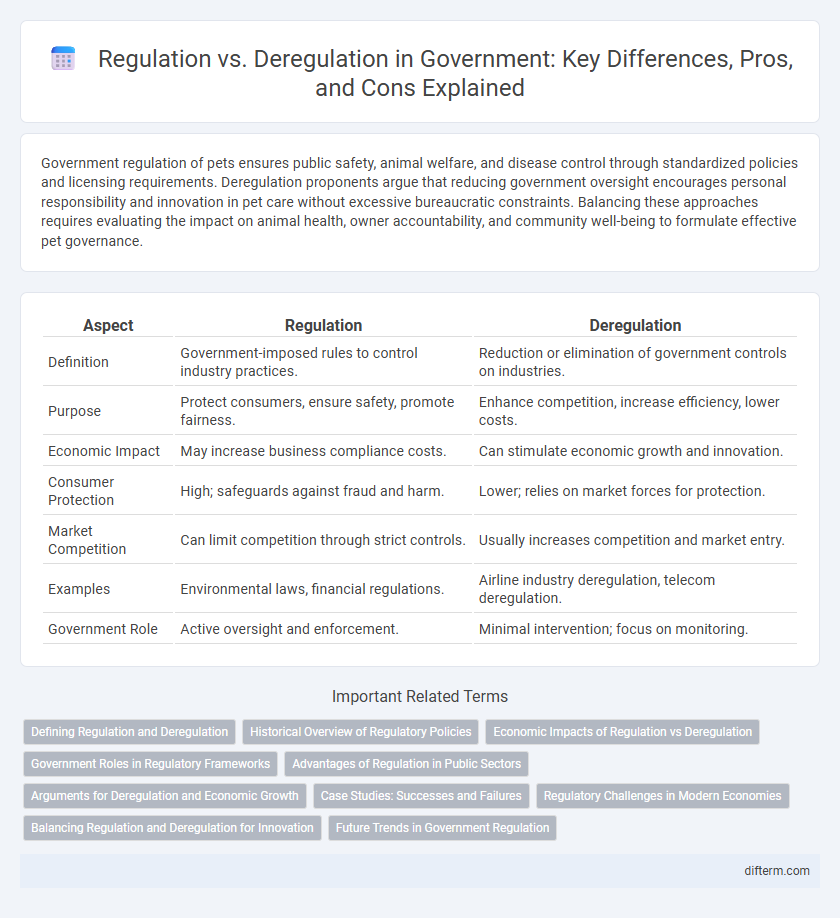Government regulation of pets ensures public safety, animal welfare, and disease control through standardized policies and licensing requirements. Deregulation proponents argue that reducing government oversight encourages personal responsibility and innovation in pet care without excessive bureaucratic constraints. Balancing these approaches requires evaluating the impact on animal health, owner accountability, and community well-being to formulate effective pet governance.
Table of Comparison
| Aspect | Regulation | Deregulation |
|---|---|---|
| Definition | Government-imposed rules to control industry practices. | Reduction or elimination of government controls on industries. |
| Purpose | Protect consumers, ensure safety, promote fairness. | Enhance competition, increase efficiency, lower costs. |
| Economic Impact | May increase business compliance costs. | Can stimulate economic growth and innovation. |
| Consumer Protection | High; safeguards against fraud and harm. | Lower; relies on market forces for protection. |
| Market Competition | Can limit competition through strict controls. | Usually increases competition and market entry. |
| Examples | Environmental laws, financial regulations. | Airline industry deregulation, telecom deregulation. |
| Government Role | Active oversight and enforcement. | Minimal intervention; focus on monitoring. |
Defining Regulation and Deregulation
Regulation refers to the implementation of rules and standards by government authorities to control industry practices and protect public interests such as safety, environment, and fair competition. Deregulation involves reducing or eliminating these governmental controls to promote economic efficiency, increase market competition, and encourage entrepreneurial innovation. Clear definitions of both ensure balanced policymaking that addresses public welfare while fostering economic growth.
Historical Overview of Regulatory Policies
Historical regulatory policies have often fluctuated between periods of stringent government oversight and phases of deregulation aimed at stimulating economic growth. Early 20th-century regulatory frameworks, such as the New Deal policies, established comprehensive controls on industries to curb market failures and protect public interests. The late 20th century saw significant deregulation, exemplified by the Airline Deregulation Act of 1978 and the Telecommunications Act of 1996, which sought to increase competition and reduce federal constraints on businesses.
Economic Impacts of Regulation vs Deregulation
Regulation typically imposes compliance costs on businesses, which can slow economic growth but enhance market stability and consumer protection. Deregulation often spurs innovation and competition by removing barriers to entry, potentially boosting productivity and lowering prices. However, excessive deregulation risks market failures, increased inequality, and reduced oversight, highlighting the need for balanced government intervention.
Government Roles in Regulatory Frameworks
Government roles in regulatory frameworks involve establishing rules and standards to protect public interests, ensure market fairness, and maintain safety. Regulatory bodies enforce compliance, monitor industry practices, and adapt policies to address emerging risks and economic changes. Effective regulation balances oversight with market efficiency, while deregulation reduces governmental constraints to promote competition and innovation.
Advantages of Regulation in Public Sectors
Regulation in public sectors ensures consistent quality and safety standards, protecting citizens from harmful practices and promoting public welfare. It fosters transparency and accountability in government operations, reducing corruption and increasing trust among the population. Regulatory frameworks also facilitate equitable access to essential services, promoting social justice and economic stability.
Arguments for Deregulation and Economic Growth
Deregulation stimulates economic growth by reducing bureaucratic barriers and fostering competitive markets, which encourages innovation and investment. Lower compliance costs for businesses lead to increased productivity and job creation across various industries. Empirical studies show that regions with deregulated sectors often experience higher GDP growth rates and improved consumer choice.
Case Studies: Successes and Failures
Case studies in government regulation reveal mixed outcomes, such as the successful Clean Air Act implementation reducing pollution and improving public health, contrasted by the deregulation of the financial sector contributing to the 2008 economic crisis. In telecommunications, deregulation fostered competition and innovation, leading to lower consumer prices, while excessive deregulation in environmental policies sometimes resulted in increased ecological damage. These real-world examples highlight the importance of balanced regulatory frameworks tailored to specific industry needs for optimal governance outcomes.
Regulatory Challenges in Modern Economies
Regulatory challenges in modern economies stem from balancing effective oversight with fostering innovation and competition. Overregulation can stifle economic growth, while deregulation risks insufficient consumer protection and financial instability. Governments must navigate complex market dynamics and evolving technologies to implement adaptive policies that ensure transparency, accountability, and market efficiency.
Balancing Regulation and Deregulation for Innovation
Balancing regulation and deregulation is crucial for fostering innovation while ensuring public safety and market stability. Effective regulatory frameworks provide standards that protect consumers and encourage fair competition, while targeted deregulation reduces barriers for startups and accelerates technological advancements. Governments must continuously evaluate policies to strike the optimal balance that supports economic growth and innovation ecosystems.
Future Trends in Government Regulation
Emerging technologies such as artificial intelligence and blockchain are driving governments to reconsider existing regulatory frameworks to balance innovation with public safety. Future trends indicate a hybrid approach where selective deregulation fosters economic growth while targeted regulations ensure data privacy and ethical standards. Governments are increasingly leveraging real-time data analytics and adaptive policy models to create more responsive and dynamic regulatory environments.
regulation vs deregulation Infographic

 difterm.com
difterm.com